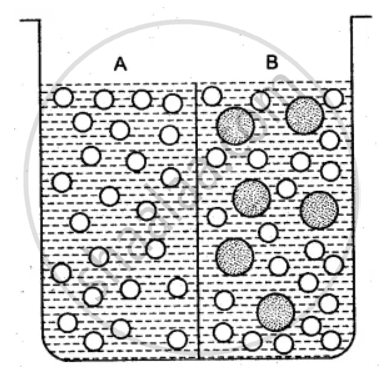Advertisements
Advertisements
प्रश्न
The following diagram represents a plant cell after being placed in a strong sugar solution.
 Guidelines 1 to 5 indicate the following
Guidelines 1 to 5 indicate the following
(1)Cell wall, (2) Strong sugar solution, (3) Protoplasm (4) Large vacuole, (5) Nucleus
(1)What is the state of the cell shown in the cell shown in the diagram?
(2)Name the structure which acts as a selectively permeable membrane.
(3)If the cell had been placed in distilled water instead of strong sugar solution, which feature would not have been seen?
(4)Name any one feature of this plant cell which is not present in an animal cell.
उत्तर
(1)The cell is flaccid i.e. it is plasmolyse
(2)Plasma Membrane
(3)Plasmolysis would not occur and flaccidity would not be seen i.e. the protoplasm would not have shrunken away from the cell wall
(4)Cell Wall is absent in animal cell.
APPEARS IN
संबंधित प्रश्न
What is responsible for guttation?
Distinguish between the following:
Turgor pressure and osmotic pressure
Choose the correct answer:
If a marine plant is transferred to fresh water, it bursts due to ___________
Two potato cubes each 1 cm3 in size, were placed separately in two containers (A and B), the container A having water and the other (B) containing concentrated sugar solution. After 24 hours when the cubes were examined, those placed in water were found to be firm and had increased slightly in size and those placed in concentrated sugar solution were found to be soft and somewhat decreased in size. Use the above information to answer the questions that follow:
Account for the softness and decrease in size of the potato cubes which were placed in sugar solution.
Give Reasons for the following.
Salt and sugar are used in preserving food.
Give Reasons for the following.
On sprinkling common salt on grass growing in a lawn, the grass is killed.
Give Reasons for the following.
The raisins swell up in the water.
The beaker is divided into two chambers A and B. The big circle represents solute and the small circles solvent.
(i) What can you say about the size of the holes in the membrane, if it is to behave semi- permeably between these two?
(ii) Will the solvent molecules pass through the membrane from left to right, from right to left, in either direction or in both directions?
(iii) In which direction will there be a net movement of solvent molecules?
During a practical exam, a plant cell in a particular solution was placed under a compound microscope. Students were told to observe the cell and name the tonicity of the solution and mention the process that occurred in the cell.

